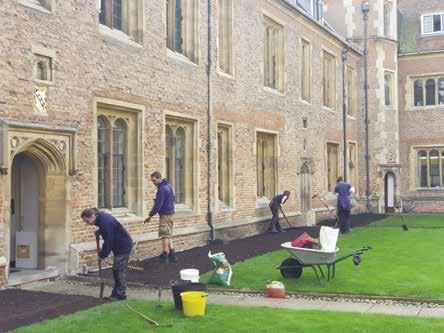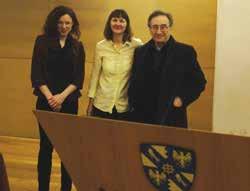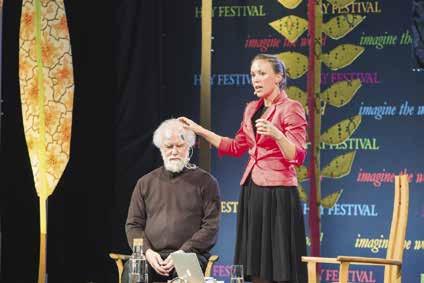
14 minute read
Return to Vahalla: The portrait of Professor William Farish by
R E T U R N T O VA L H A L L A
THE PORTRAIT OF PROFESSOR WILLIAM FARISH BY HENRY PERRONET BRIGGS
Advertisement
In a past edition of the College Magazine, Gareth Atkins commented on the removal of the College’s portrait of Charles Kingsley from Hall, and taught us all a good deal more about Kingsley in the process. 1 Recent visitors and eagle-eyed residents may have noticed that Kingsley’s replacement has now been replaced in its turn. Not by the father of The Water Babies (he now presides over Benson Hall), but by H P Briggs’s portrait of Professor William Farish (1757–1837).
William Farish by Henry Perronet Briggs, 1813
The name of William Farish is probably less familiar to most readers than that of Charles Kingsley. So why the preference? After all, authority for Kingsley’s place in what Dr Atkins calls the College’s ‘Valhalla’ comes from no less than Benson himself who, in The leaves of the tree (1912), recalls how the ‘strangely contrasted’ portraits of Kingsley and Pepys ‘gaze at each other across the long tables’ of his College’s ‘little paneled hall’. 2 Farish’s cause finds support in nothing so romantic. His prior claim, however, is clearly attested in the first edition of Le Keux’s Memorials of Cambridge (1842), which in turn draws on a description in The Cambridge Guide of 1830. 3
In fact, the original usurpation of Farish was not by Kingsley; his portrait was not painted until 1862. 4 By then, Farish had already been moved to the Combination Room, seemingly in order to make room for a grand rendition of George Neville-Grenville. 5 The Reverend and Honourable George Neville (the -Grenville was added later) became Master of Magdalene in 1813 at the grand old age of twenty-four. His qualifications included being a younger son of the 2nd Baron Braybrooke, in whose gift the appointment lay.
George Neville-Grenville (1789 –1875) by H W Pickersgill, 1846x54
Our story moves briefly to a shop in Bath, and a bunch of nineteenthcentury letters through which I was browsing recently (as you do). My eye fell upon one addressed ‘To Mr H. P. Briggs, 71 Berners Street, Oxford Street’. The name rang a bell, so I read on. The next thing I saw were the words ‘Magdalene Lodge’ in the top right-hand corner. Post-marked ‘7 o’clock’ on 22 March 1819, the letter reads:
Magdalene Lodge March 21st
The Vice Chancellor of Cambridge begs to acknowledge Mr Briggs’ obliging letter and to opine him how very much pleased he is with the prospect of having this excellent picture of [Mr?] Professor Farish placed in Magdalene College. The Vice Chancellor begs Mr Briggs will accept his best thanks for the great addition he is making to the collection of portraits at Magdalene College, & will thank him to order a handsome gilt frame on the behalf of the College, in order that full justice may be done to so admirable a performance. 6

Letter from George Neville-Grenville to H P Briggs, dated 21 March 1819
Before the twentieth century, the Vice-Chancellorship rotated for a year at a time between the Heads of House. Thus, in 1818–19, it was the turn of the (by now) twenty-nine-year-old Master of Magdalene, the aforementioned George Neville. His correspondent, Henry Perronet Briggs, was younger still. Probably born in Walworth, London, in 1793, Briggs was about twenty-six in 1819. By then, his portrait of Farish (like Neville’s mastership) was already six years old.
Briggs, who died in 1844, has been served rather meanly by art historians. Writing in the 1860s, those most Victorian of commentators, Richard and Samuel Redgrave, dismissed his work as that which, whilst ‘not without merit, … cannot be said to belong to the highest class of art’. 7 His flesh tones come in for particular criticism. Their judgment was parroted almost word-for-word in the Dictionary of National Biography twenty years later. 8 Briggs’s contemporaries, however, held him in higher esteem. For W M Thackeray he was ‘out and out the best portrait-painter of the set’. 9
Although exaggerated, Thackeray’s report does Briggs the greater justice. By then, however, he was a well-established member of the Royal Academy. In fact, Briggs had made his name in London as a history and subject painter, and it was only after his marriage in 1830 and election to the R A in 1832 that he turned his focus back to the more lucrative business of portraiture. His portrait of Farish is
the work of a young man with just two years of formal training behind him, and is all the more impressive for that.
Some sources suggest that Briggs’s father, John Hobart Briggs, was an amateur artist. 10 Certainly, he moved in artistic circles. His cousin’s daughter was Amelia Opie, best known in her own right as an author and activist, but also the wife of John Opie, Professor of Painting at the Royal Academy Schools until his death in 1807. Briggs Senior subscribed to Amelia’s publication of her late husband’s lectures in 1809. He was also friends with the brothers R and J B Cuming, both of whom exhibited at the Academy in the 1790s. The early emergence of his son’s artistic talents seems to have been encouraged. After the younger Briggs’s death in 1844, Amelia Opie remembered his father ‘dwell with great pleasure on his son’s rapid progress’ during a visit to her in Norwich many years earlier. 11 Briggs’s first published works appeared as early as 1806 in the Gentleman’s Magazine, alongside a letter from his tutor extolling ‘the juvenile efforts of a rising young genius’. 12

Views of Epping Church, by H P Briggs, Gentleman’s Magazine, 1806
This combination of talent and family connections accounts for Briggs’s admission to the Royal Academy Schools on 26 February 1811, and on 5 April
to draw in the British Museum ‘on the recommendation of Mr Northcote’ (coincidentally, it was James Northcote’s death in 1832 that made room for Briggs’s own election as a Royal Academician). Two years later, in 1813, Briggs moved to Cambridge ‘and painted a professor and many of the members of colleges there’. 13 The professor in question was William Farish; Briggs was, at most, twenty-one.
Why he came here, and what led him to paint the portraits that he did remains a mystery, although, once again, it may be that family connections played a part. Besides Farish, he painted at least one other member of the College: Thomas Kerrich, the University Librarian. Kerrich was a fine amateur artist in his own right, and had been producing portraits of Cambridge worthies since his own undergraduate days. Like Briggs, he also came from a long-established Norfolk family, and may have looked to offer the young artist an opportunity. 14 Apparently, Kerrich not only sat for Briggs but also bought the painting; it was subsequently in the possession of his daughter, Frances Hartshorne. 15 His satisfaction with it is confirmed by its engraving and publication in London by G S Facius in June 1815. The Facius brothers had been reproducing copies of Kerrich’s works since the 1770s. The printing of his portrait almost certainly resulted from their relationship with the subject rather than the artist, but it seems to have given the artist an idea.
Thomas Kerrich (1748–1828) by G S Facius after H P Briggs
However it was that Briggs came to paint William Farish, the portrait was not a commission: we know from the letter above that it was still in the artist’s possession in 1819. By the time Facius’s engraving of his portrait of Kerrich appeared, Briggs was living back in London. He seems to have decided that
his large study of Professor Farish could profitably be given the same treatment. He arranged for it to be engraved by Henry Dawe, and published it himself. The print’s inscription gives the details:
Rev. William Farish M.A. / Jacksonian Professor of Philosophy in the
University of Cambridge. / Painted by H.P. Briggs. / Engraved by Henry
Dawe. / London, Published by Mr. Briggs No. 6, Old Compton Street, Soho,
Oct.r 21, 1815.

Revd William Farish MA, engraved mezzotint by H Dawe after H P Briggs, 1815
The painting itself evidently remained unsold, hence the correspondence with Vice-Chancellor Neville in 1819. By this point, Briggs had moved from Old Compton Street to 71 Berners Street; and from portraiture to history painting. Perhaps his change of direction made it unnecessary for him to keep the large canvas, which might otherwise have been used to showcase his skills to potential patrons. Having commissioned its frame, as requested by Neville, he passed it into the College’s possession. Neville’s letter makes clear that it met with approval, presumably with its subject as well as his Fellows: it was hung in the Hall during Farish’s lifetime.
So much for the artist. What of the sitter?
The son of a Cumbrian vicarage, William Farish matriculated at Magdalene as a sizar (a scholar of sorts) in 1774, the same year in which the College installed its twentyfirst Master. 16 The improbably-named Barton Wallop proved to be spectacularly hopeless in the job, but he was also admirably absent and that left the College in the care of its capable President, Samuel Hey. As well as a young Thomas Kerrich, recently returned from the Grand Tour, the fellowship at the time included the brilliant Edward Waring, Lucasian Professor of Mathematics since 1760. Wallop was succeeded as Master in 1781 by the eminently more suitable Peter Peckard.
More than two centuries on, Waring may still reign as the College’s brightest mathematical star, but William Farish retains a place in the firmament. In 1778, he followed in his older colleague’s footsteps by graduating as Senior Wrangler, adding first place in Smith’s Prize for good measure. He was quickly elected to a fellowship and appointed as a tutor. Made a deacon in 1780, admitted MA in 1781, and ordained a priest in 1782, he became Professor of Chemistry in 1794. In 1813, shortly before Briggs painted his portrait, Farish was elected as the third Jacksonian Professor of Natural Philosophy. The latter event may well have provided the motivation for the former.
For ‘natural philosophy’ in the twenty-first century we can read ‘natural science’. As it is, Farish was to be known to posterity as the world’s first de facto professor of engineering. When first appointed to his chair of chemistry, he knew that the principles of the subject were already well covered in the lectures offered by his colleague F J H Wollaston. Farish, therefore, decide to indulge his fascination with practical application. He delivered what was effectively the first course of university lectures in engineering in 1794.
To aid his demonstration of practical mechanics in these lectures, Farish made further innovations. He designed a collection of ‘loose brass wheels … axes [sic] of various lengths … bars, clamps … frames, and whatever else might be necessary to build up the particular machines … for one lecture’, which may then ‘be taken down, and the parts built up again, in a different form, for the lecture the following day’. To the delight of children down the ages, and for the most admirable of pedagogical reasons, Farish had created the prototype of Meccano. 17

Infusion pump made from Meccano used in physiology experiments in the 1960s
He next set his mind to finding a way in which similar principles could accurately be communicated in 2D. The result here was the first systematic set of rules for drawing in isometric, which he outlined in the inaugural paper of the Cambridge Philosophical Society’s Transactions. 18 Our sense of Farish’s standing is further enhanced by the knowledge that he had earlier been elected as the Society’s first President.
Brilliant, innovative, and pious, the softly-spoken Farish was also inclined towards diffidence and absent-mindedness, all in the best professorial tradition. 19 The portrait painted of him by the young Briggs successfully captures many of these traits. His pose is learned, his hand resting on a vast open tome; his expression manages at once to capture both distance and engagement. The arc of the mechanical model beside him shadows the fine dome of his cranium. Unusually, the strings of Farish’s academic gown are tied in a bow. This seems to have been his habit: they appear the same way in an almost contemporary drawing of him by Thomas Uwins.
William Farish, by Thomas Uwins, 1815. © Trustees of the British Museum
Farish the innovator is of interest to anyone who has struggled through the tripos for another reason too, because I’m afraid that this is also the man who invented the modern examination. He’s sometimes credited with creating written examinations in their entirety; in fact those had begun to emerge by the middle of the eighteenth century. What Farish did was to revolutionise the way the examinations were assessed. Before his appointment to the office of University Moderator in the 1790s, examiners had relied on their well-honed powers of discernment in order to class each student’s performance. The fact that the system
was open to subjectivity and bias had been attracting complaints for decades. 20 It made the ranking of candidates within each degree class controversial, and effective moderation practically impossible. To combat this, Farish developed the concept of grading students’ performances quantitatively, assigning for the first time a proportion of marks to each individual question and adding them together to produce a definitive overall grade. Discussion of the full consequences of this in the more recent history of education is probably best left for another time.
Technical drawing, quantitative assessment, the university study of engineering, even Meccano, all owe their innovation, in full or in part, to William Farish. Writing in the College Magazine in 1955, Dr K R Webb goes on to list the wide ‘catholicity of applied scientific interests’ covered in his lectures, from coalmining and cotton production to inland navigation and civil engineering. 21 Farish was an enthusiastic early exponent of steam power. Less predictably, his ‘model of a self-acting trough for flushing closets’ was exhibited in the year he died. Finally, notes Webb, he was fascinated by the construction of bridges and aqueducts, ‘ships, docks, harbours and naval architecture. Here, surely, is a man whom Pepys of all men would have loved to acknowledge as a twin saint!’ 22 The evangelical Farish would no doubt have preferred to imagine himself amongst the saints than the einherjar, but never mind: his portrait by the similarly precocious and under-celebrated H P Briggs is surely worthy of its place in our collegiate Valhalla. J M M
1 G W Atkins, ‘One of Our Portraits is Missing! Charles Kingsley (1819–1875)’, Coll Mag 56 (2011–12), pp 55-68. 2 A C Benson, The leaves of the tree (1911), p 230. 3 The Universities: Le Keux’s Memorials of Cambridge, II (1842), p 8; The Cambridge Guide (1830), p 165. 4 By Cato Lowes Dickinson (1819–1908). The College’s version is a slightly later copy. 5 C H Cooper, Memorials of Cambridge, II (1861), p 184. The portrait was subsequently moved again to Benson Hall, where it hung until the Hall was re-decorated in 2012 (see Magdalene Described, p 23). 6 The letter is offered for sale by Samwells of Bath Ltd. 7 R and S Redgrave, A Century of British Painters (1866), pp 78-79. 8 W W Wroth, ‘Briggs, Henry Perronet (1793–1844)’, Dictionary of National Biography, 6 (1886), p 327. 9 W M Thackeray, Frasers Magazine, 17/102 (1838), p 759; ‘the set’ being the Royal Academicians of the time. 10 M Myrone, ‘Drawing after the Antique at the British Museum’, British Art Studies, 5 (2017). 11 Mrs S C Hall, The Art-Union, 6 (1844), p 88 12 Gentleman’s Magazine (April 1806), p 313. 13 Hall, p 88 14 See D Robinson, ‘Thomas Kerrich (1748–1828): Portrait of a Magdalene Artist’, Coll Mag (2002–03), pp 53-64. It might be noted that Kerrich himself produced at least two portraits of women with the surname Briggs, of whom one lived in Norfolk (the other was Elizabeth Briggs, the College Laundress), but there is no evidence of a family connection with H P Briggs in either case. 15 A copy currently hangs in the Parlour. 16 Articles about Farish have twice appeared in the College Magazine in the past: see C Smyth, ‘William Farish, 1759–1837’, Coll Mag, 76 (1937), pp 281-86; K R Webb, ‘William Farish, 1799–1837’, Coll Mag, 86 (1955), pp 25-9. The latter is an abbreviated version of an article that appeared in Chemistry and Industry (1955). 17 W Farish, ‘On Isometrical Perspective’, Trans. Cam. Phil. Soc., 1 (1822), pp 1-20 (at pp 1-2). 18 ibid. 19 See M D Archer and C D Haley (eds), The 1702 Chair of Chemistry at Cambridge (2005), esp. pp 105-06; as well as the College Magazine articles by Smyth and Webb, cited above. 20 ibid., p 106. 21 Webb, p 27. 22 ibid.










